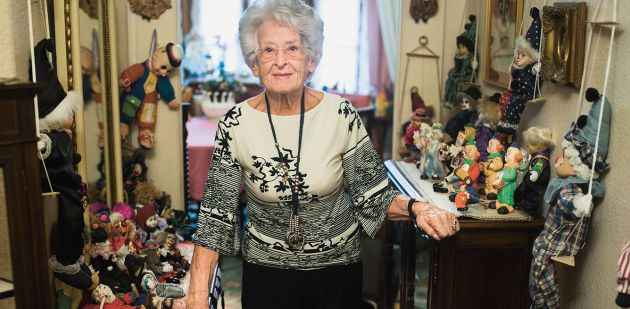There are more and more people age 80 and over and, due to their frailty, they have special medical needs.

It’s a relatively quiet midweek morning in the emergency room at Lausanne University Hospital (CHUV), when the ambulance pulls up to bring in an older patient, the victim of a fall. The elderly lady is rapidly tended to by the geriatrics specialist on duty, undergoing an initial set of tests to evaluate her condition: questioning, blood test, X-rays.
“This initial assessment is essential in measuring the patient’s overall state of health and bringing her an immediate medical response if necessary,” says Andreina D’Onofrio, a specialised clinical nurse with the Geriatrics Unit at the CHUV. “The next step is to determine what her condition was before her accident.” Annie is 81 and has been alone since the death of her husband. She still lives at home. While climbing onto a stool, she lost her balance and fell hard on her side. She came to the hospital on the advice of her cleaning lady, who provides additional information for the healthcare staff. They want to know if this fall is the first, if Annie was able to get back up on her own and if she has had any recent problems keeping her balance.
As her condition does not require immediate medical care, Annie is sent to the Geriatrics and Geriatric Rehabilitation Unit. The process is a well-established one, a series of steps designed to produce an objective assessment of Annie’s situation based on indicators specifically designed for the patients who come into the unit. “We try to retrace the exact circumstances of the fall and assess Annie’s physical and psychological condition to provide the geriatric physicians with objective information for formulating their diagnosis,” says Andreina D’Onofrio. Annie is then recommended care that is suited to her situation.
Thirty percent of people over age 90 suffer from Alzheimer’s disease.
Over the next few days, Andreina D’Onofrio and her colleagues will gradually assess Annie’s condition based on eight scales used to measure a number of criteria: hyperactivity or atony, nutritional problems, dehydration, signs of depression, etc. This methodical approach helps determine which strategy is best adapted and where Annie will go next: back home or to a long-term care facility. Having recovered well, she can go home, bringing with her the cane recommended by her doctors.
The challenge of losing independence
Annie’s case is actually quite common among people entering their later years. According to Christophe Trivalle, geriatrics physician at Paul-Brousse Hospital in Villejuif and author of “Vieux et malade: la double peine!” (L’Harmattan, 2010), this is a complex notion. “The definition of old age is not reduced to a mere number, especially with biological decline occurring later than before. Often it comes when a dramatic deterioration suddenly deprives them of their independence.” What we refer to as “old age” is when physical restrictions severely limit normal day-to-day activities: getting up, eating, going to bed, going to the toilet, shopping, preparing food. Daily life becomes increasingly difficult to handle, frequently compromising the quality of their social life. The turning point occurs around age 83. That is the average age when most Swiss people grow vulnerable. The main focus during Annie’s stay at the CHUV was precisely to assess her degree of frailty and her ability to regain the daily life she had had before.
This is a poignant social and medical issue, as communities currently struggle with the economic challenge of handling the explosion in patients over age 85. In Switzerland, 20% of healthcare costs go to sick people age 80 and over, but this age group only represents 5% of the Swiss population. These elderly patients, along with the Americans and Norwegians, rank among the top three most protected groups in the world according to the OECD, but their growing number will only make problems increasingly worse. Although “ageing is not a disease,” as Christophe Trivalle points out, old age tends to be a time of “polypathology”. “The elderly are characterised by having multiple diseases simultaneously, which increase in frequency as they get older.” They couple diabetes or high blood pressure with neurodegenerative conditions, and the frequency keeps rising with age. Thirty percent of people over age 90 suffer from Alzheimer’s disease.
Patients and healthcare providers agree on one point. Leaving their home must happen as late as possible. “Avoiding or reducing the period of dependency is essential from a human point of view, not to mention the economic aspect,” says Christophe Trivalle. “The elderly need to regain a feeling of well-being despite the physical decline, even if that means adapting their lifestyles and reinventing a balance with their environment.” This is closely related to the position of the elderly in our society and our view of them.
Old age is a form of inequality in terms of health and death. There is a higher proportion of women as the population ages. Over age 80, there are nearly twice as many women (64%) as men (36%). Although men enjoy slightly better health than women, they decline and die sooner.
For both healthcare staff and doctors, caring for the elderly can be an exhausting enterprise. Patients can get confused, anxious and sometimes upset or even aggressive. They rip out IVs, pinch and bite. Treating them requires extraordinary patience and perseverance.
Retirement age may be a time when people are prone to depression, but psychiatric care for the elderly faces challenges of its own. Practitioners are often required to reduce medical treatments, as the side effects of certain molecules can aggravate the physical condition of elderly patients.